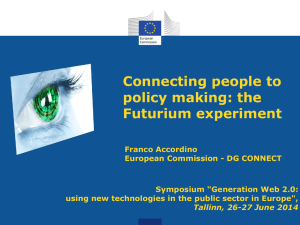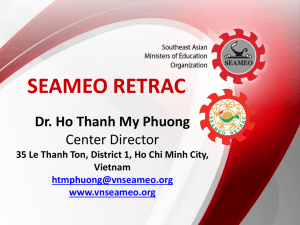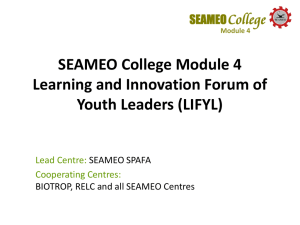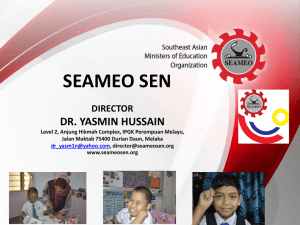Lecture
advertisement
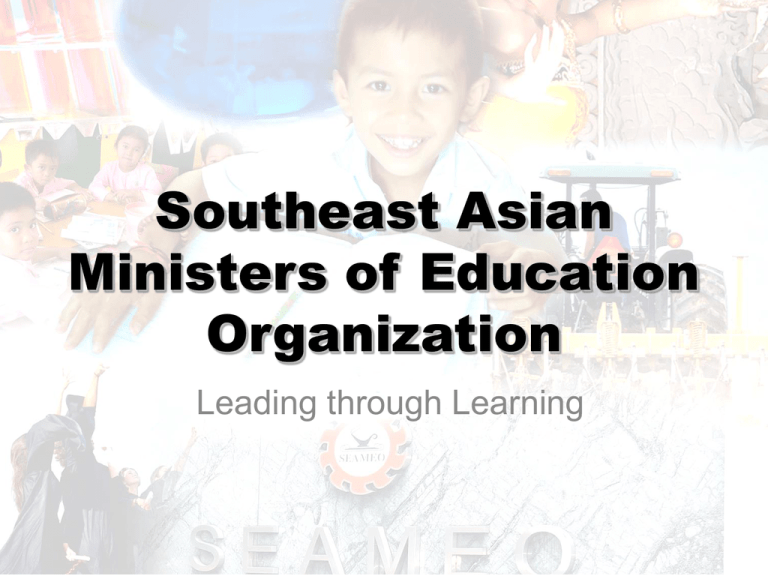
Southeast Asian Ministers of Education Organization Leading through Learning The Purpose of SEAMEO SEAMEO is a chartered international and intergovernmental organization established in 1965 to promote cooperation in education, science and culture in Southeast Asia. • • • Establishes network and partnerships Provides intellectual forums for policy makers and experts Promotes sustainable human resource development • Develops and nurtures the capacities of teachers and school managers in Southeast Asia through 20 SEAMEO specialist institutions Member Countries Indonesia (1965) Lao PDR (1965) Malaysia (1965) Philippines (1965) Singapore (1965) Thailand (1965) Cambodia (1971) Brunei Darussalam (1984) Vietnam (1992) Myanmar (1998) Timor-Leste (2006) Associate Members Australia (1973) France (1973) New Zealand (1974) Canada (1988) Germany (1990) Netherlands (1993) Spain (2007) United Kingdom (2013) Affiliate Members International Council for Open and Distance Education (1999) University of Tsukuba (2009) British Council (2010) Vision The leading organization for enhancing regional understanding and cooperation in education, science and culture for a better quality of life in Southeast Asia Mission To enhance regional understanding, cooperation and unity of purpose among Member Countries for a better quality of life through – the establishment of networks and partnerships, – the provision of fora among policy makers and experts, and – the promotion of sustainable human resource development 20 SEAMEO Regional Centres and a Regional Network on Tropical Medicine and Public Health 1. 2. 3. 4. 5. 6. 7. 8. 9. 10. 11. 12. 13. 11 Regional Centres for Education 2 Regional Centres for Culture 7 Regional Centres for Science Areas of Expertise Areas of Expertise Areas of Expertise Innovative Education and Technology Science and Mathematics Education Language Education Vocational and Technical Education Higher Education Special Education Open Learning/ Distance Education Education Management Teacher Capacity Building 1. 2. 3. 4. Cultural Development Archaeology Fine Arts History and Traditions 1. 2. 3. 4. 5. 6. 7. Agriculture Tropical Biology Natural Resource Management Tropical Medicine Public Health Food and Nutrition Futures, Foresight and the Development of Education in Southeast Asia Dr Witaya Jeradechakul Director, SEAMEO Secretariat Bangkok, Thailand witaya@seameo.org secretariat@seameo.org Imagine the Future https://alumni.tsukuba.ac.jp/ The Futures 1. Not just the Future but Futures 2. Futurists can not predict the future. No one can. A prediction is intended to be true and accurate statement. But we all can forecast futures. A forecast is intended to be logical and useful statement about the futures. 3. Futures studies help institutions and individuals envision, design, and move towards preferred futures rather than passively accepting whatever “will be”. 4. But to be effective the process of forecasting and envisioning must be done continuously and not just a one-shot activity The Futures and Time Horizon 1. But when is the present, when does the future begin? 2. Most people are only interested in “now”. 3. Some planners and policy-makers may be interested in the next five, ten, or maybe 15 years. 4. Futurists begin to take interest from between 20 to 50— maybe 100—years from now. 5. Beyond 100 years is speculation, imagination and fiction. The Futures and Time Horizon DEGREE OF PARTICIPATION futures research planning administration MAGNITUDE OF INTENDED ACTIONS TIMELINE AND DEGREE OF FLUX James Dator, University of Hawaii Plausible versus Preferred Futures Plausible Futures Preferred Futures What might happen: trends forecasts, scenarios Values, mission, vision, Goals, strategies, actions We need to understand this Dreams and imagination We need to create this Impact and Uncertainty high impact Drivers high impact, low uncertainty Potential Drivers high impact, high uncertainty low uncertainty high uncertainty Background Trends Inconsequential low uncertainty, low impact high uncertainty, low impact low impact What is Foresight • Systematic attempts to look into the future (of science, society, economy – and their interactions) in order to promote social, environmental and economic benefit • Foresight study is a process of anticipating and managing changes Key Elements of Foresight Study 1. 2. 3. 4. 5. 6. 7. Structured Anticipation Interactive and Participative Methods New networks Strategic Visioning For present day decision and action Social Benefits and Disbenefits Why Foresight is Important 1. Globalization 2. Constraints on government spending 3. Change in management and industrial production 4. Changes in the structure of and demand for knowledge production 5. Increasing uncertainties for the future Framework of Foresight Inputs Foresight process • • • Analysis Interpretation Prospection Outputs Strategy Strategic scanning of environment/ Delphi • Emerging issues/ trends analysis • Systematic thinking/ causal layout analysis • Scenarios visioning, backcasting, roadmaps Reports, presentations, workshops Multimedia Strategy development and strategic planning Global picture of Education/ EFA/ MDGs including Issues & Trends Country Priorities, Issues and Challenges on Education + Regional Initiatives on EFA Goals and MDGs First Discussion + Analysis (Global versus Country Issues) Futures/Preferred/ Worst Case Scenario, etc Pre-2015 versus Post-2015 – What is missing and what are the new targets Consultations using Foresight and 4 Futures Gap Analysis Second Discussion + Analysis Gap analysis New set of education agenda Delphi Survey (2 rounds) Selected target groups Verify the agenda Presentation of Findings and the Post2015 Agenda to SEAMEO Education Ministers and other Stakeholders Example used by SEAMEO in developing Post-2015 Education agenda Range of Futures/ Foresight between “Push and Pull” PUSH Foresight about the future of technology aimed at technology .. and priority setting PULL Foresight about the future of technology aimed at identifying technology for economic and social change Foresight about social and economic needs and ways in which these might be solved with the help of Technology Foresight about social and economic needs aimed at identifying ways to alleviate social and economic conditions SEAMEO Consultation and Development of Post-2015 Education Scenarios and PostEFA Education Agenda in Southeast Asia Development of Post-2015 Education Agenda in Southeast Asia Drivers of change Post-2015 short (2015-2020) & long-term (2015-2035) recommendations to address the 4 future futures Emerging Issues & Trends guided by the 4 futures but other parameters such as the ASEAN Community, values and cultures 4 Generic Futures of Manoa School Achievements In Education Challenges Next step: Determining preferred future Development of SEAMEO Strategic Plan (2011-2020) Golden SEAMEO 12 SEAMEO initiatives scenario building key success factors grouping the initiatives: unique, shared and common Imagine Imagine there's no heaven It’s easy if you try No hell below us Above us only sky Imagine all the people living for today Imagine there's no countries It isn’t hard to do Nothing to kill or die for And no religion too Imagine all the people living life in peace You, you may say I’m a dreamer, but I'm not the only one I hope some day you'll join us And the world will be as one Imagine Imagine no possessions I wonder if you can No need for greed or hunger A brotherhood of man Imagine all the people sharing all the world You, you may say I'm a dreamer, but I'm not the only one I hope some day you'll join us And the world will live as one http://www.bretlsimmons.com/2011-07/leadership-foresight/ Thank you very much. Futures, Foresight and the Development of Education in Southeast Asia Dr Witaya Jeradechakul Director, SEAMEO Secretariat Bangkok, Thailand witaya@seameo.org secretariat@seameo.org
